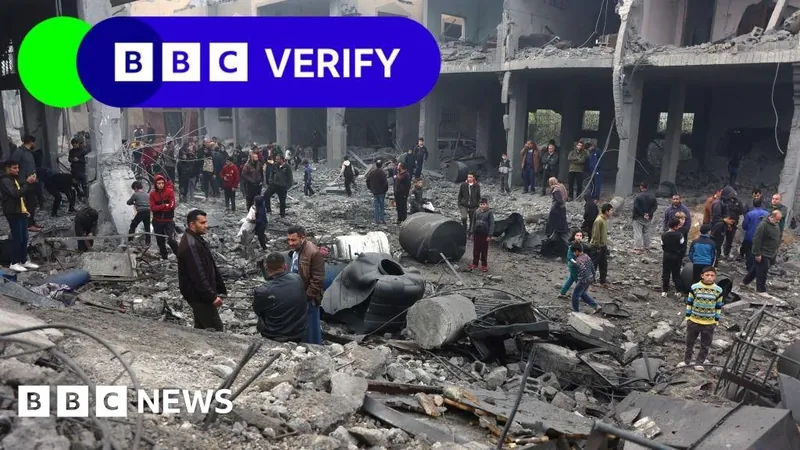
Unprecedented Devastation: The Impact of 15 Months of War on Gaza
2025-01-16
Author: Yan
A groundbreaking ceasefire agreement has finally emerged from Qatar, aiming to halt the 15-month conflict between Israel and Hamas that has wreaked havoc on Gaza. This ongoing violence was ignited by a shocking attack from Hamas in October 2023, resulting in the loss of approximately 1,200 lives and the hostage of 251 individuals.
Death Toll and Casualties
As of January 2024, the death toll reported by health officials in Gaza stands at a shocking 46,788, with figures suggesting that about 59% of these deaths involve women, children, and the elderly. However, a United Nations analysis suggests that the actual figure for women and children could be as high as 70%. Moreover, the conflict has resulted in over 110,453 injuries, and according to the World Health Organization (WHO), a quarter of these individuals are now enduring life-altering injuries.
Karin Huster, a coordinator with Médecins Sans Frontières (MSF), emphasized the immense challenges facing Gaza’s health system, which is struggling to cope with the unprecedented number of injured individuals. Recent studies published in esteemed medical journals like The Lancet have hinted that the real death toll could be much higher than official estimates.
Destruction of Infrastructure and Healthcare
The scale of infrastructural destruction in Gaza is shocking. A detailed analysis using satellite imagery reveals that nearly 60% of buildings in the Gaza Strip have been damaged or destroyed since the war began. Other estimates from the United Nations Satellite Centre (UNOSAT) suggest that an alarming 69% of all structures within Gaza have suffered damage.
Hospitals are particularly hard-hit. The UN reports that half of Gaza’s hospitals are non-operational, with those that remain open unable to treat chronic illnesses or complex injuries adequately. The health crisis is compounded by the tragic loss of around 1,060 medical workers and the destruction of key mental health facilities, while hundreds of education institutions have also been targeted, further obstructing the region's recovery.
Displacement and Humanitarian Aid
The ongoing conflict has forcibly displaced around 1.9 million people—approximately 90% of Gaza’s population—who are now constantly relocating to escape the violence. Continuous strikes and military operations have compelled nearly all residents of the 2.3 million-strong population to abandon their homes, with the northern Gaza area sustaining particularly heavy evacuation and destruction.
As food insecurity escalates, the UN warns that up to 91% of Gaza's residents are facing acute levels of hunger. The challenges facing agricultural recovery are extreme, with a staggering 67.6% of cropland damaged, further exacerbating the humanitarian crisis.
Aid distribution has become increasingly difficult, with only a fraction of the required supplies making it into Gaza compared to pre-conflict levels. Despite a potential easing of restrictions post-ceasefire, logistical challenges remain, including the threats posed by looting and civil strife.
The Long Road Ahead
As reconstruction begins, experts estimate that rebuilding Gaza could take over a decade, and the costs are projected to balloon to around $40 billion. With significant infrastructural and humanitarian challenges still ahead, the path to recovery for Gaza's displaced population remains fraught and complex.
While the ceasefire is a glimmer of hope, the real test lies in the long-term rebuilding and healing of a region scarred by unprecedented violence and loss. The world watches as Gazans strive to reclaim their lives and rebuild their homes amidst continued uncertainty.



 Brasil (PT)
Brasil (PT)
 Canada (EN)
Canada (EN)
 Chile (ES)
Chile (ES)
 Česko (CS)
Česko (CS)
 대한민국 (KO)
대한민국 (KO)
 España (ES)
España (ES)
 France (FR)
France (FR)
 Hong Kong (EN)
Hong Kong (EN)
 Italia (IT)
Italia (IT)
 日本 (JA)
日本 (JA)
 Magyarország (HU)
Magyarország (HU)
 Norge (NO)
Norge (NO)
 Polska (PL)
Polska (PL)
 Schweiz (DE)
Schweiz (DE)
 Singapore (EN)
Singapore (EN)
 Sverige (SV)
Sverige (SV)
 Suomi (FI)
Suomi (FI)
 Türkiye (TR)
Türkiye (TR)
 الإمارات العربية المتحدة (AR)
الإمارات العربية المتحدة (AR)